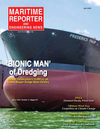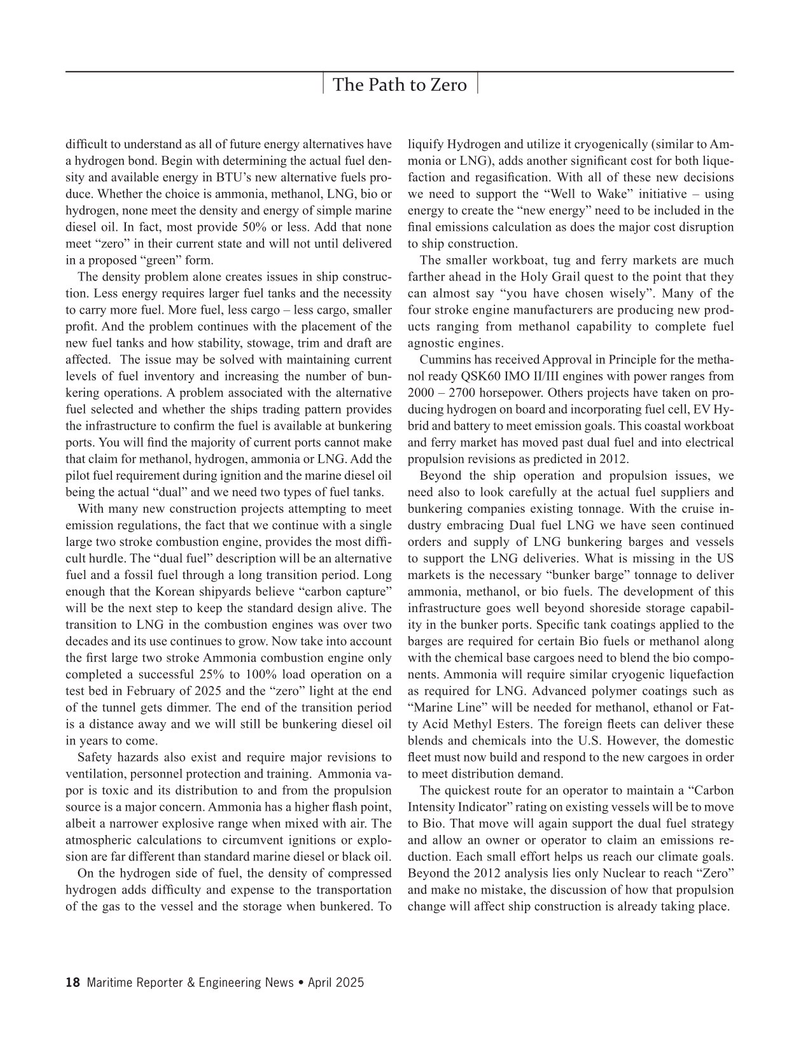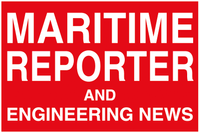
Page 18: of Maritime Reporter Magazine (April 2025)
Read this page in Pdf, Flash or Html5 edition of April 2025 Maritime Reporter Magazine
The Path to Zero dif? cult to understand as all of future energy alternatives have liquify Hydrogen and utilize it cryogenically (similar to Am- a hydrogen bond. Begin with determining the actual fuel den- monia or LNG), adds another signi? cant cost for both lique- sity and available energy in BTU’s new alternative fuels pro- faction and regasi? cation. With all of these new decisions duce. Whether the choice is ammonia, methanol, LNG, bio or we need to support the “Well to Wake” initiative – using hydrogen, none meet the density and energy of simple marine energy to create the “new energy” need to be included in the diesel oil. In fact, most provide 50% or less. Add that none ? nal emissions calculation as does the major cost disruption meet “zero” in their current state and will not until delivered to ship construction. in a proposed “green” form. The smaller workboat, tug and ferry markets are much
The density problem alone creates issues in ship construc- farther ahead in the Holy Grail quest to the point that they tion. Less energy requires larger fuel tanks and the necessity can almost say “you have chosen wisely”. Many of the to carry more fuel. More fuel, less cargo – less cargo, smaller four stroke engine manufacturers are producing new prod- pro? t. And the problem continues with the placement of the ucts ranging from methanol capability to complete fuel new fuel tanks and how stability, stowage, trim and draft are agnostic engines. affected. The issue may be solved with maintaining current Cummins has received Approval in Principle for the metha- levels of fuel inventory and increasing the number of bun- nol ready QSK60 IMO II/III engines with power ranges from kering operations. A problem associated with the alternative 2000 – 2700 horsepower. Others projects have taken on pro- fuel selected and whether the ships trading pattern provides ducing hydrogen on board and incorporating fuel cell, EV Hy- the infrastructure to con? rm the fuel is available at bunkering brid and battery to meet emission goals. This coastal workboat ports. You will ? nd the majority of current ports cannot make and ferry market has moved past dual fuel and into electrical that claim for methanol, hydrogen, ammonia or LNG. Add the propulsion revisions as predicted in 2012.
pilot fuel requirement during ignition and the marine diesel oil Beyond the ship operation and propulsion issues, we being the actual “dual” and we need two types of fuel tanks. need also to look carefully at the actual fuel suppliers and
With many new construction projects attempting to meet bunkering companies existing tonnage. With the cruise in- emission regulations, the fact that we continue with a single dustry embracing Dual fuel LNG we have seen continued large two stroke combustion engine, provides the most dif? - orders and supply of LNG bunkering barges and vessels cult hurdle. The “dual fuel” description will be an alternative to support the LNG deliveries. What is missing in the US fuel and a fossil fuel through a long transition period. Long markets is the necessary “bunker barge” tonnage to deliver enough that the Korean shipyards believe “carbon capture” ammonia, methanol, or bio fuels. The development of this will be the next step to keep the standard design alive. The infrastructure goes well beyond shoreside storage capabil- transition to LNG in the combustion engines was over two ity in the bunker ports. Speci? c tank coatings applied to the decades and its use continues to grow. Now take into account barges are required for certain Bio fuels or methanol along the ? rst large two stroke Ammonia combustion engine only with the chemical base cargoes need to blend the bio compo- completed a successful 25% to 100% load operation on a nents. Ammonia will require similar cryogenic liquefaction test bed in February of 2025 and the “zero” light at the end as required for LNG. Advanced polymer coatings such as of the tunnel gets dimmer. The end of the transition period “Marine Line” will be needed for methanol, ethanol or Fat- is a distance away and we will still be bunkering diesel oil ty Acid Methyl Esters. The foreign ? eets can deliver these in years to come. blends and chemicals into the U.S. However, the domestic
Safety hazards also exist and require major revisions to ? eet must now build and respond to the new cargoes in order ventilation, personnel protection and training. Ammonia va- to meet distribution demand. por is toxic and its distribution to and from the propulsion The quickest route for an operator to maintain a “Carbon source is a major concern. Ammonia has a higher ? ash point, Intensity Indicator” rating on existing vessels will be to move albeit a narrower explosive range when mixed with air. The to Bio. That move will again support the dual fuel strategy atmospheric calculations to circumvent ignitions or explo- and allow an owner or operator to claim an emissions re- sion are far different than standard marine diesel or black oil. duction. Each small effort helps us reach our climate goals.
On the hydrogen side of fuel, the density of compressed Beyond the 2012 analysis lies only Nuclear to reach “Zero” hydrogen adds dif? culty and expense to the transportation and make no mistake, the discussion of how that propulsion of the gas to the vessel and the storage when bunkered. To change will affect ship construction is already taking place.
18 Maritime Reporter & Engineering News • April 2025
MR #4 (18-33).indd 18 4/2/2025 8:55:07 AM

 17
17

 19
19
